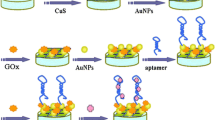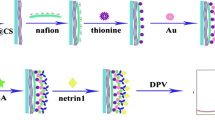Abstract
We describe a new kind of electrochemical immunoassay for the peptide hormone prolactin. A glassy carbon electrode (GCE) was modified with a hybrid material consisting of graphene, single walled carbon nanotubes and gold nanoparticles (AuNPs) in a chitosan (CS) matrix. The graphene and the single wall carbon nanotubes were first placed on the GCE, and the AuNPs were then electrodeposited on the surface by cyclic voltammetry. This structure results in a comparably large surface for immobilization of the capturing antibody (Ab1). The modified electrode was used in a standard sandwich-type of immunoassay. The secondary antibody (Ab2) consisted of AuNPs with immobilized Ab2 and modified with biotinylated DNA as signal tags. Finally, alkaline phosphatase was bound to the biotinylated DNA-AuNPs-Ab2 conjugate via streptavidin chemistry. The enzyme catalyzes the hydrolysis of the α-naphthyl phosphate to form α-naphthol which is highly electroactive at an operating voltage as low as 180 mV (vs. Ag/AgCl). The resulting immunoassay exhibits high sensitivity, wide linear range (50 to 3200 pg∙mL‾1), low detection limit (47 pg∙mL‾1), acceptable selectivity and reproducibility. The assay provides a pragmatic platform for signal amplification and has a great potential for the sensitive determination of antigens other than prolactine.

The immunoassay for prolactin is based on a glassy carbon electrode modified with SWCNTs, graphene and antibody-coated gold nanoparticles, and a secondary antibody conjugated to other gold nanoparticles via a biotinylated DNA linker





Similar content being viewed by others
References
Freeman ME, Kanyicska B, Lerant A, Nagy G (2000) Prolactin: structure, function, and regulation of secretion. Physiol Rev 80(4):1523–1631
Moreno-Guzmán M, González-Cortés A, Yáñez-Sedeño P, Pingarrón JM (2011) A disposable electrochemical immunosensor for prolactin involving affinity reaction on streptavidin-functionalized magnetic particles. Anal Chim Acta 692(1):125–130
Sinha YN (1995) Structural variants of prolactin: occurrence and physiological significance. Endocr Rev 16(3):354–369
Fahie-Wilson M, Smith TP (2013) Determination of prolactin: the macroprolactin problem. Best Pract Res Clin Endocrinol Metab 27(5):725–742
Banerjee S, Paul P, Talib VJ (2004) Serum prolactin in seizure disorders. Indian Pediatr 41(8):827–831
Bole-Feysot C, Goffin V, Edery M, Binart N, Kelly PA (1998) Prolactin (PRL) and its receptor: actions, signal transduction pathways and phenotypes observed in PRL receptor knockout mice. Endocr Rev 19(3):225–268
Smith TP, Suliman AM, Fahie-Wilson MN, McKenna TJ (2002) Gross variability in the detection of prolactin in sera containing Big prolactin (macroprolactin) by commercial immunoassays. J Clin Endocrinol Metab 87(12):5410–5415
Roy KS, Prakash BS (2007) Development and validation of a simple, sensitive enzyme immunoassay (EIA) for quantification of prolactin in buffalo plasma. Theriogenology 67(3):572–579
Mondal M, Rajikhowa C, Prakash BS (2007) Development and validation of a highly sensitive economic enzymeimmunoassay for prolactin determination in blood plasma of mithun (Bos frontalis) and its application during milk let down and cyclicity. Anim Reprod Sci 99(1):182–195
Kudryavtsev AN, Krasitskaya VV, Petunin AI, Burakov AY, Frank LA (2012) Simultaneous bioluminescent immunoassay of serum total and IgG-bound prolactins. Anal Chem 84(7):3119–3124
Rojanasakul A, Udomsubpayakul U, Chinsomboon S (1994) Chemiluminescence immunoassay versus radioimmunoassay for the measurement of reproductive hormones. Int J Gynaecol Obstet 45(2):141–146
Chikkaveeraiah BV, Bhirde AA, Morgan NY, Eden HS, Chen XY (2012) Electrochemical immunosensors for detection of cancer protein biomarkers. ACS Nano 6(8):6546–61
Nie H, Liu S, Yu R, Jiang J (2009) Phospholipid-coated carbon nanotubes as sensitive electrochemical labels with controlled-assembly-mediated signal transduction for magnetic separation immunoassay. Angew Chem Int Ed 48(52):9862–6
Wang J, Lin YH (2008) Functionalized carbon nanotubes and nanofibers forbiosensing applications. TrAC Trends Anal Chem 27(7):619–626
Chuvilin A, Bichoutskaia E, Gimenez-Lopez MC, Chamberlain TW, Rance GA, Kuganathan N, Biskupek J, Kaiser U, Khlobystov AN (2011) Self-assembly of a sulphur-terminated graphene nanoribbon within a single-walled carbon nanotube. Nat Mater 10(9):687–692
Chen X, Zhu J, Xi Q, Yang WS (2012) A high performance electrochemical sensor for acetaminophen based on single-walled carbon nanotube–graphene nanosheet hybrid films. Sensors Actuators B Chem 161(1):648–654
Gan T, Hu SS (2011) Electrochemical sensors based on graphene materials. Microchim Acta 175(1–2):1–19
Lu JJ, Liu SQ, Ge SG, Yan M, Yu JH, Hu XT (2012) Ultrasensitive electrochemical immunosensor based on Au nanoparticles dotted carbon nanotube–graphene composite and functionalized mesoporous materials. Biosens Bioelectron 33(1):29–35
Zhu J, Chauhan DS, Shan D, Wu XY, Zhang GY, Zhang XJ (2014) Ultrasensitive determination of hydrazine using a glassy carbon electrode modified with Pyrocatechol Violet electrodeposited on single walled carbon nanotubes. Microchim Acta 181(7–8):813–820
Zhang L, Li C, Zhao D, Wu T, Nie G (2014) An electrochemical immunosensor for the tumor marker α-fetoprotein using a glassy carbon electrode modified with a poly (5-formylindole), single-wall carbon nanotubes, and coated with gold nanoparticles and antibody. Microchim Acta 81(13–14):1601–1608
Khorsand F, Darziani Azizi M, Naeemy A, Larijani B, Omidfar K (2013) An electrochemical biosensor for 3-hydroxybutyrate detection based on screen-printed electrode modified by coenzyme functionalized carbon nanotubes. Mol Biol Rep 40(3):2327–2334
Liu Y, Liu Y, Feng HB, Wu YM, Joshi L, Zeng XQ, Li JH (2012) Layer-by-layer assembly of chemical reduced graphene and carbon nanotubes for sensitive electrochemical immunoassay. Biosens Bioelectron 35:63–68
Zhao MQ, Liu XF, Zhang Q, Tian GL, Huang JQ, Zhu WC, Wei F (2012) Graphene/single-walled carbon nanotube hybrids: one-step catalytic growth and applications for high-rate Li–S batteries. ACS Nano 6(12):10759–10769
Cheng Q, Tang J, Ma J, Zhang H, Norio SY, Qin LC (2011) Graphene and carbon nanotube composite electrodes for supercapacitors with ultra-high energy density. Phys Chem Chem Phys 13(39):17615–17624
Huang KJ, Li J, Liu YM, Cao X, Yu S, Yu M (2012) Disposable immunoassay for hepatitis B surface antigen based on a graphene paste electrode functionalized with gold nanoparticles and a Nafion-cysteine conjugate. Microchim Acta 177(3–4):419–426
Ding L, Bond AM, Zhai JP, Zhang J (2013) Utilization of nanoparticle labels for signal amplification in ultrasensitive electrochemical affinity biosensors: a review. Anal Chim Acta 797:1–12
Han E, Ding L, Ju HX (2011) Highly sensitive fluorescent analysis of dynamic glycan expression on living cells using glyconanoparticles and functionalized quantum dots. Anal Chem 83(18):7006–7012
Shao K, Wang J, Jiang XC, Shao F, Li TT, Ye SY, Chen L, Han HY (2014) Stretch − stowage − growth strategy to fabricate tunable TriplyAmplified electrochemiluminescence immunosensor for ultrasensitive detection of pseudorabies virus antibody. Anal Chem 86:5749–5757
Song C, Xie GM, Wang L, Liu LZ, Tian G, Xiang H (2014) DNA-based hybridization chain reaction for an ultrasensitive cancer marker EBNA-1 electrochemical immunosensor. Biosens Bioelectron 58:68–74
Zhang B, Liu BQ, Tang DP, Niessner R, Chen GN, Knopp D (2012) DNA-based hybridization chain reaction for amplified bioelectronic signal and ultrasensitive detection of proteins. Anal Chem 84:5392–5399
Tang J, Tang DP, Su BL, Huang JX, Qiu B, Chen GN (2011) Enzyme-free electrochemical immunoassay with catalytic reduction of p-nitrophenol and recycling of p-aminophenol using gold nanoparticles-coated carbon nanotubes as nanocatalysts. Biosens Bioelectron 26:3219–3226
Kim KS, Zhao Y, Jang H, Lee SY, Kim JM, Kim KS, Ahn JH, Kim P, Choi JY, Hong BH (2009) Large-scale pattern growth of graphene films for stretchable transparent electrodes. Nature 457(7230):706–710
Guo SJ, Wang EK (2007) Synthesis and electrochemical applications of gold nanoparticles. Anal Chim Acta 598(2):181–192
Acknowledgments
This work was funded by the National Natural Science Foundation of China (81371904) and (81101638), the Natural Science Foundation Project of CQ (CSTC2013jjB10019).
Author information
Authors and Affiliations
Corresponding author
Additional information
Shengqiang Li and Yurong Yan contributed equally to this work.
Electronic supplementary material
Below is the link to the electronic supplementary material.
ESM 1
(DOC 6900 kb)
Rights and permissions
About this article
Cite this article
Li, S., Yan, Y., Zhong, L. et al. Electrochemical sandwich immunoassay for the peptide hormone prolactin using an electrode modified with graphene, single walled carbon nanotubes and antibody-coated gold nanoparticles. Microchim Acta 182, 1917–1924 (2015). https://doi.org/10.1007/s00604-015-1528-2
Received:
Accepted:
Published:
Issue Date:
DOI: https://doi.org/10.1007/s00604-015-1528-2




